STEPPING OUT OF THE ONSHORE RUTS
The reality of sailing waves in onshore winds is that it’s easy to do – but hard to do well. In the first episode of a two-parter, Harty offers technical and tactical advice about how to rip up the mush.
Words Peter Hart // Photos Hart Photography, Simon Bassett / 2XS, John Carter/ PWA, getwindsurfing.com
Figures are awaiting confirmation, but 92.7% of all windsurfers who sail waves learned in onshore winds; and having learned, they then continue to sail waves in onshore winds for 84% of the time until they hang up their split-toe booties. For some it’s an active choice – they embrace the inherent security in the ‘on’ bit of ‘onshore.’ But most are just victims of geography and oceanography. Waves are generated by wind – so you’re most likely to find waves on a shore that faces the prevailing wind. Hence wind and waves most commonly arrive together from roughly the same direction. Wind blowing side offshore over a cleanly defined groundswell, demand freakish environmental combinations – like a secondary weather system or a fortuitously placed underwater obstruction to refract the waves. They’re the skier’s sunny powder snow day. It’s lovely when it happens … but don’t set your watch by it. Even in those locations where you believe such conditions are normal, they’re not as normal as you’d like them to be. The message is, don’t waste your time expecting and waiting for perfection. Embrace onshore conditions, learn to sail them well and the extra tools you gather doing so will allow you to murder those clean swells on the offshore days.
The nature of the Challenge
‘Onshore’ is a mammoth subject in terms of range of conditions (how onshore, how big, small, clean, confused are the waves?) and potential moves. So in this first feature I’m going to narrow it down and shed light on the challenge that causes the most confusion – how to ride waves down-the-line (DTL) in onshore winds. DTL, by the way (BTW) means riding downwind facing the wave, front side. To start let’s compare the idyll to what we’re most likely to confront.
Even in those exotic spots famous for producing opposing swell and wind directions, perfect side-off riding doesn’t happen as often as you think. It’s just that when it does, the resident snapper captures the moment as if it were the norm.
Why is offshore easier?
Side-off is the dreamy, DTL wind direction. Assuming there’s a swell and they have the skill to get out there and manoeuvre to the right spot, people find the act of front side riding not just easy but immediately achievable because:
1. The waves are so much easier to spot. They’re lines marching in over an otherwise smooth sea.
2. The wind may not be very strong – so they don’t have power control issues and are not fighting a tiny ‘on off’ sail. (I know … because the wave carries you into the wind, the build up of apparent wind can be over-powering but only if it’s very offshore and the waves are big and fast.)
3. The wave face is almost certainly smoother. You know from gybing how much more confidently you commit to and drive the rail when the water is flat.
4. The wind holds the wave up, stops it breaking – so there’s less white water, and more unbroken face to work with. It’s also steeper with more power to redirect the board (and, yes, more power to send you over the falls).
5. And surely the most significant factor is that as you catch the wave you have no choice except to go down-the-line. That’s your natural reaching course back to the beach. You can’t physically ride it upwind backside (well you can but it will be dead into wind and you’d have to park the sail). And when you are riding front side, the bottom and top turns take place between a tight and broad reach on the original tack. You never have to turn through the wind. It’s the quadrant where it’s easiest to carve the board and control the power.
GYBING REFLECTIONS
You get a good idea how someone will fair in onshore wave riding from their gybe, and specifically one section of the gybe – the transition. The transition is where the board turns through the wind and where suddenly you’re confronted by opposing forces. You have to stay committed to the rail with knees and hips facing the centre of the circle and at the same time open the sail out and resist the outward pull of the rig. Feeling this twist at the hips, many stand up, centre themselves over the board, which then levels out and stops downwind. And that’s what will happen with their wave ride. The best exercise for onshore riding is on flat water, hanging onto the gybe longer and try to sail away for a few seconds in that switch foot clew first position.?

The key gybing skill to work on for onshore riding is to keep the sail powered and keep carving through the wind.
PHOTO Simon Bassett 2XS
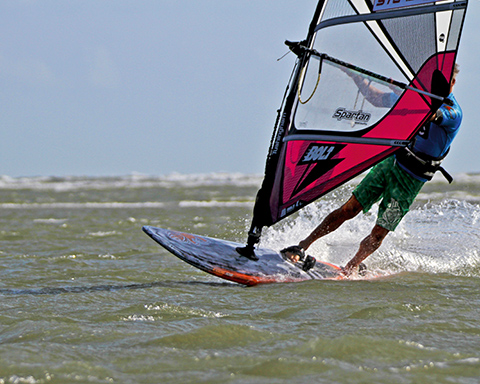
As you turn through the wind, open the clew out early and let your back hip move towards your back hand. Hold those angles so you exit clew first and switch foot.
PHOTO Simon Bassett 2XS
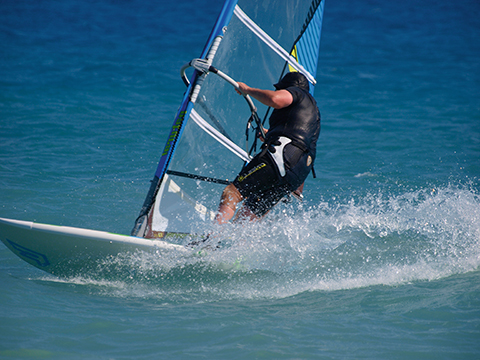
Clew closed and body straight and upright over the board – the carve will end downwind as will his wave ride.
PHOTO Hart Photography
Onshore – the greater challenge
When the wind swings onshore, all the above four points are ‘different’ – different as in ‘initially a bit of a nightmare’.
1. The onshore sea state can be a random mess – lumps and bumps everywhere – impossible to work out which lump will bear fruit.
2. It’s not always the case, but decent waves usually arrive c/o a strong wind, which may produce power control issues.
3. With so much room to build up, there’s chop everywhere. The challenge lies in finding a smooth spot on which to lay a rail.
4. The onshore wind blows the tops over prematurely. White water abounds. The waves tend to be ‘slopier’ and less punchy. It’s hard to be dynamic and put the board in places where the wave does the work. At least there’s less chance of breaking kit.
5. And here’s the really tricky bit. In onshore winds the ride takes you through the wind on one tack to the other. You’re not only downwind most of the time (power control hell) but to stay powered up and carving you need to sail switch foot (the feet in the ‘wrong’ set of straps) and clew first = very technical.
Let’s dive into the shoes of the willing but confused onshore rider. He gets out through the break, gybes (well done) and by luck or judgement picks up a wave that is walling up nicely. Here’s the typical sequence of misjudgements. His natural reaching course will take him upwind diagonally back to the beach so he’s riding the wave with his back to it. A downwind ride is 180° in the other direction, dead downwind. It feels all wrong. But, in for a penny, he’ll try and do what they do in the movies and carve downwind towards it. He drops down the wave, hits the bottom, eases onto the edge, carves off downwind, slows down and is met by an eerie silence. There is no wave to be seen or heard. Five seconds later the wave he shot out in front of finally catches him up and engulfs him.
He has a word with himself and deduces he overtook the wave because his bottom turn was too late and too wide. The cure obviously is to tighten it up by carving sooner and more aggressively.
Take 2 – He catches the wave and immediately cranks it over whereupon the rail buries in the wave face, trips and he … well he’s not sure what happened next but it involved an underwater 360.
Take 3 – Split the difference. Don’t carve quite so aggressively, especially not on the wave face itself, which is steep and curved and grabs at the edge.
So this time he delays a little and turns hard as soon as he reaches the flat in front. It’s going well but just as he’s climbing the face ready for the top turn, it’s as if a helicopter had decided to hover overhead, and he gets back-winded and slammed. Progressing from there, he becomes more aware of the wind direction and sail angle, and like a gybe, continually opens the clew and sheets out and tries to present the sail to the wind at all stages of the turn. However, although he’s heading off in the general downwind direction, the rides mostly remain infrequent, sluggish, lacking in ‘whoosh’ and ‘snap’ and generally unsatisfactory. Improvement starts with tactics and ending up on the right day on the right section of wave with the right kit.
Kit Choice
The subject of board choice in onshore conditions is as broad as it is tall – and is a subject we will dissect more thoroughly when in the next issue we get views from our men on the beach. The truth is you can ride down-the-line on any board with ‘wave’ in the title (wave or fsw) but you’ll have to do it differently. There are multiple situations but hear this. Wind blown waves tend to be slow. And with the wind from behind it’s all too easy to outrun them. What’s needed, therefore, is a board that naturally turns tight and fast – and nothing does that better than a modern multi-fin wave board. The short length gives it a tight tuning circle. The wide tail and the side fins react well to sudden pressure and drive the board round, at the point where a narrow tailed board would sink and stall. And taking it to the level where you are really attacking the wave and gouging the bottom turn, the most important feature of the modern multi-fin is its ability to carve at relatively slow speeds without stalling. That means you can be waiting at the top of the wave and then drop and carve immediately without having to accelerate out onto the flat. Being able to turn actually on the wave face is key, but there’s more to come on that …
Onshore winds and sloppy waves are the perfect arena for a zippy freestyle wave.But if you specifically want to ride waves there’s another design that’s even better for the job. There’s a clue in its title…
Sail size
In onshore winds your sail choice is primarily governed by the general situation. It’s an upwind exercise. You need to get through the shorebreak, plane off the beach and jump. You’re battling against the wind. For all the above you need power. You take what you need. It’s a skill thing. The good guys need less and would rather go a little bigger on volume. Riding waves with too much sail is a nightmare. Most of the onshore DTL ride happens within 45° of dead downwind where the power is hardest to hide. With too much power the wild mastfoot pressure tends to bury the rails and overpower the fins, especially on tight top turns. Having said that, I prefer a little too much to too little. It could be my speed/slalom background. I don’t mind power; it just encourages me to go faster.
Your three wave riding priorities are speed, speed and speed.
DIFFERENT DAYS – DIFFERENT RIDES
There is no one way to do this thing. It all depends on wind strength and how onshore it is – and above all the size and power of the waves. Also note – if you’re trying this for the first time, the nearer the wind is to side shore, the easier it is. If it’s more than 45° onshore, you have to turn yourself inside out to stay powered up. So here are 3 different situations and approaches but the aim is the same – to maintain speed.
Without speed, you can’t carve powerful turns and throw spray.
Without speed, the board will trip and stall.
Without speed, there is no flow from edge to edge through the transitions.
Without speed, the sail loads up and heaves you out of shape.
In all these situations I’m assuming there are reasonable waves to work with. Not just peaking wedges but some, however messy, with reasonable length to give you room to bear away.
CHANGING LINES
In all wave riding your number one priority is deciding on the right line and where and when to do your top and bottom turns, which of course changes with every situation. In onshore riding in particular, generating speed on the wave without out-running it is the elusive skill. Pozo in Gran Canaria is most famous for its jumping – but it’s also where you’ll see the highest level of onshore wind wave riding. Below we have two alternatives. The first, easier, is to pivot downwind on top of the wave, stay high, accelerate and then steer off the top and then back down the face. The second is technically a lot more demanding and involves dropping straight into a bottom turn, initiating it on the face and gouging brutally hard, all the time keeping the sail open. The latter is more exciting but with a tiny window for error. A full rail bottom turn actually on the face is easy to stack and only really possible with a dedicated wave board (preferably with more than one fin.)
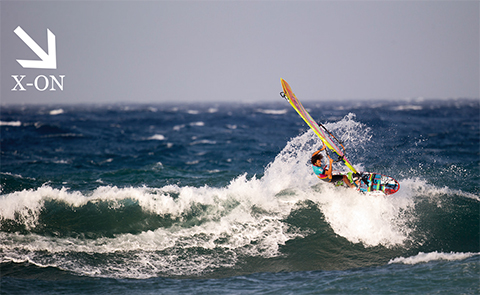
X-ON > The more achievable line – check the track – staying high on the wave before dropping into the top turn..
PHOTO Carter/PWA
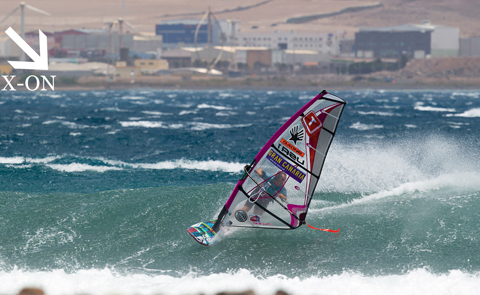
X-ON > A full tilt onshore bottom turn on the face from Graham Ezzy.
PHOTO Carter/PWA
Ride 1 – the ‘squirt’ turn – clew first DTL.
You can gauge the brilliance of your riding by how long you stay on the wave face and how little time you spend on the flats out in front of it. The following approach is useful for all situations to get you facing the right direction and help you generate speed.
Out the back heading in, moderate your speed and chug upwind looking back over your front shoulder for a swell with some shape. One comes. You bear away onto it. Hopefully at this stage it’s just a benign, sloping face. Now head upwind along it, not just to gain ground, but also to open up the space for you to ride downwind. Slow down and let yourself drift to the top.
Looking downwind you see it walling up nicely. The squirt turn is basically half a flare/pivot gybe. Almost stationary with both feet in the straps, drop the back hand right back, tilt the rig to windward, sheet in, power up the back foot and at the same time drop the hips back and to the inside (towards the back hand). The board squirts/pivots round at the top of the wave. As it reaches downwind, open the clew out and rock onto your front foot to kill the rotation. You’ll now be facing downwind along the wave and, if that squirt was good and tight, you’ll still be at the top of the wave.
Now lean forward, keep the rig forward, accelerate down and along the wave and above all hold the clew open so it’s always above the wave. Two or three seconds of that is all you need to generate impressive speed.
To complete a top turn and redirect down the wave, all you have to do is look over the front shoulder at the beach, move the hips down the hill and pressure the heels. Pull up on the toes and if possible present the underside of the board to the lip or the white water and let it bang the board round. As the board turns upwind, move the back hand forward to keep the sail open.
What was all that about?
The pivot turn at the top of the wave replaces the bottom turn so you don’t outrun it but get a feeling for generating speed from the wave by staying high.
You get the crucial idea of opening the clew and keeping it above the wave. The clew below the level of the wave is an accident waiting to happen.
With a simple 90° top turn you grasp that the sail stays in the same plane all the time and the board just turns under it.
BOTTOM TURNS VARIOUS
To excel in onshore winds you have to erase from your mind the Maui-esque image of what you want your bottom turn to look like – rig sheeted right in and laid to the floor and you peering along the mast at the lip you want to smack – that’s only possible in a side or side-off wind where you’re initiating your turn across the wind (like a gybe). The onshore wind bottom turn is a different animal. You take up the same angles but with rig totally clew first – how clew first depends how onshore the wind is.

X-Off > The classic Ho’okipa lay-down bottom turn from Brawzinho. It’s a beautiful thing but only possible in side or side off winds. (BTW the photo has been flipped for a better comparison)..
PHOTO Carter/PWA

X-Off > The same move in Pozo’s side onshore winds (more ‘on’ than ‘side’) beautifully executed by Victor Fernandez. To get this angle of ‘gouge’ and hold the sail clew first takes strength,
athleticism and rubbery hips. PHOTO Carter/PWA
Ride 2 – bigger waves – more wall, speed – drop and bottom turn.
It starts the same as above – cruising upwind along the unbroken face, stopping, pivoting round, levelling off and heading down the line high on the wave. But this time you use that speed to drop into a proper bottom turn.
Drop diagonally down the face onto the flat to give yourself room to turn. The bottom turn in slow waves has to be tight. But don’t just hoof on the back foot or you’ll stop. You lean forward as you drop, powering down through the boom to lay the rail in the water.
The key element is the back hand and the sheeting angle. If you’re not over-powered, push the rig forward and open it out for maximum power.
If you are over-powered, over-sheet a little but be prepared to sheet out immediately. As you carve, push your hips towards the wave and immediately open the back hand so you can see the wave past the clew. Hold that clew first position as you climb back up the wave.
To start with don’t look to smack any lips but go for an early top turn and a more gentle redirection. As before, look down the slope, power up the heels, move the back hand forward to hold the clew high and open. Keep turning on the heels until you’re facing back upwind.
What was all that about?
Introducing a proper bottom turn followed by immediate top turn, there has to be agile, dynamic weight shift from rail to rail, the hips predicting the changes of direction and making themselves the centre of the circle.
Making bigger faster turns, you now have to stay oriented, be constantly aware of the wind direction and adjust the sheeting angle accordingly. You discover it’s much easier and more efficient to sheet in and out by moving the back hand up and down the boom rather than pushing and pulling.
Ride 3 – world cup glory – drop and go – snap snap!!
One easy way to measure the difference between the riding performances of a Pro and an Am is the time between their bottom and top turns. With an Am it can be an eon, as they bumble off clew first to a different county before finally redirecting. With the pros it’s 2 seconds or less.
Watch the world cuppers ride at Pozo. It’s 50 knots and very onshore over the punchy shorebreak wave – if ever there was an excuse for screaming 100 metres out in front … But they’re riding upwind and then suddenly, snap! and snap! They’ve banged out a downwind bottom and top turn in the blink of an eye.
Of course it demands huge commitment and some cute depowering skills – but this is the way to take your onshore DTL up a notch. The difference to our second ride is that you’re missing out the ‘squirt’ turn. Instead, from heading upwind, you drop straight into a full power bottom turn.
Think of pro bottom turns and you think of Jason Polakow hooting out onto the flats, dropping his rig in front of a Pe’ahi monster and staring at the lip along the tip of his mast. But there’s no time for that now, the wave is too small and slow. If you lay the rig down, you’ll never have time to get it back up again in time for the top turn.
You have to initiate the turn and set the rail actually on the wave face. And then with the back hand so far back it’s almost on the clew, extend the front arm forward to sheet in – at the same time driving that power into the back section of rail to snap the board round (it is a carve, not a pivot). Releasing that pressure is the trigger for you to snap the other way off the lip.
The difference here is that you don’t try to power up clew first for any length of time. Instead, you open out the clew and top turn all in one movement. There is SO much room for error. Number one, making such sudden changes of directions, the power surges in the sail are wild – and if you don’t have your body exactly in the right position, it’s curtains.
What was all that about?
It’s the next level and above all, about exploiting the board’s designed ability to initiate turns suddenly (without a bear away) and gouge deeply without tripping. That first ride we did, you were turning through 90° – this time it’s through 180° and back again – that’s wave riding. And to make such turns, hand movements have to be even more exaggerated. The rule with such a bottom turn is, move the back hand back to where you normally have it – and then another yard.
The beauty of White Water
In onshore winds white water abounds so get used to it. There are many kinds of foam and it’s not all bad. The ‘bad’ stuff rebounds off the seabed and explodes following the top to bottom breaking of a powerful swell – give it a wide berth. But in onshore winds the waves often get blown over and crumble from the top. There’s a layer of white but underneath is solid water. This is good stuff. Wave-riding you can bottom turn towards it, present the underside of the board – and because the water is actually moving, you get an explosive reaction from it, similar to a pitching lip – but not so destructive.

Harty getting redirected by some solid Irish foam.
PHOTO ( Getwindsurfing)
COMMON QUESTIONS answered
We’ve hardly scratched the surface but here are solutions to some of the most common onshore DTL issues.
I take off, bear away to ride and the wave disappears.
You gotta look before you go. If downwind there is no wall, then wait.
Unlike real surfing, you’re often not taking off on the peak but behind it so your bottom turn takes you towards a breaking section.
The key tip is always to ride upwind on the wave you’re going to ride downwind. On good days you make a figure of 8. Ride upwind, foot off down the line, top turn, ride upwind again and repeat the process as the wave reforms.
I’m ending up miles downwind every time.
Unlike in side off wind, where DTL riding is effectively taking you across the wind, in onshore winds you DTL ride is pretty much dead downwind. So I refer to the tip above, put some money in the bank by riding upwind first.
I can’t bottom turn in onshore winds without bouncing.
Cutting you some slack, it may be the conditions. If the water on and in front of the wave is choppy, it’s a mission to carve smoothly. Choose your spot more carefully. The waves out to sea may be bigger but the deeper the water, the bigger the chop. Often the inside waves that have reformed in shallow water are smoother and more fun.
DOWN the LINE Onshore
This was one of the best days of the recent winter period. The wind had swung more westerly (only 20° onshore) and the relentless winds had generated a proper swell. In this sequence, former pro Jamie Hawkins displays all the key elements of an onshore ride – the line, the timing and power control. All the way through the sequence the sail stays at the same angle to the wind and the board just turns underneath it.

After a wide bottom turn he makes the transition to the heel edge early. A good line in has left him right by the peak. Check the height of the clew.

Rocking onto his front heel, he presents the nose to the white water and looks and projects himself down the slope in anticipation of the acceleration. It’s very tempting here to yank on the back hand – but don’t, you’re too broad to the wind. PHOTO (Hart Photography)
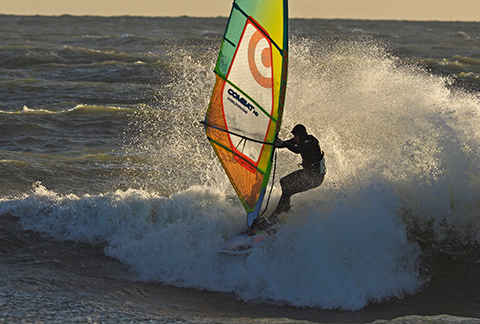
Great power control – the back hand slides forward and he opens the sail right out to dump the excess power and send a load of spray into the February sun.
From a technique standpoint, there are 2 main reasons for bouncing.
1. Running too flat a board. Wave boards especially are much more stable on their edge where they can knife through the chop.
2. No power control. If you get over-powered as you fly off DTL, you’ll lean back and sheet out. With the nose riding high, you’ll bounce for Britain. Get the power under control before driving into a tight bottom turn.
I get overpowered and/or catapulted as I get to the top of the wave and try to top turn – even with my back hand right forward.
It’s very very common and usually down to NOT enough turn in your top turn. Remember where the wind is. In an onshore wind, if you top turn to face straight back down the wave, you’re on a broad reach = catapult territory. Commit to the heels longer to keep the board turning until you are across the wind, facing upwind along the wave.
It can also be from opening the clew too much. When it’s really breezy you leave the back hand back a little on the boom to keep the clew closed in order to deliberately oversheet and depower.
Getting worked is also a symptom of losing all your speed.
I always stall my top turn. I either lose speed, or even worse, flop off the back. It’s all too popular a gaffe in onshore DTL.
There are multiple reasons.
Could be poor wave selection and top turning too late on a wave with no ‘throw’ – i.e. there’s no power or slope to help redirect the board.
The commonest technical reason is simple over-sheeting. It’s so tempting to initiate top turns by falling against the sail and pulling on your back hand. In onshore winds you initiate the top turn very broad, clew first on the other tack. So if you pull on the back hand you immediately oversheet, or worse still, pull the clew through the wind and get backwinded.
Next month, I’ll uncover deeper layers of onshore hell, or is it now heaven? And I’ll be abetted by sailors, pro and weekend warrior alike, who have had more sailing this winter than is strictly legal and are keen to share their recent experiences and discoveries.
Misery for you all since Harty’s foreign clinics are full through to November. But check his website, www.peter-hart.com, and his Peter Hart Masterclass fb page for UK dates.

